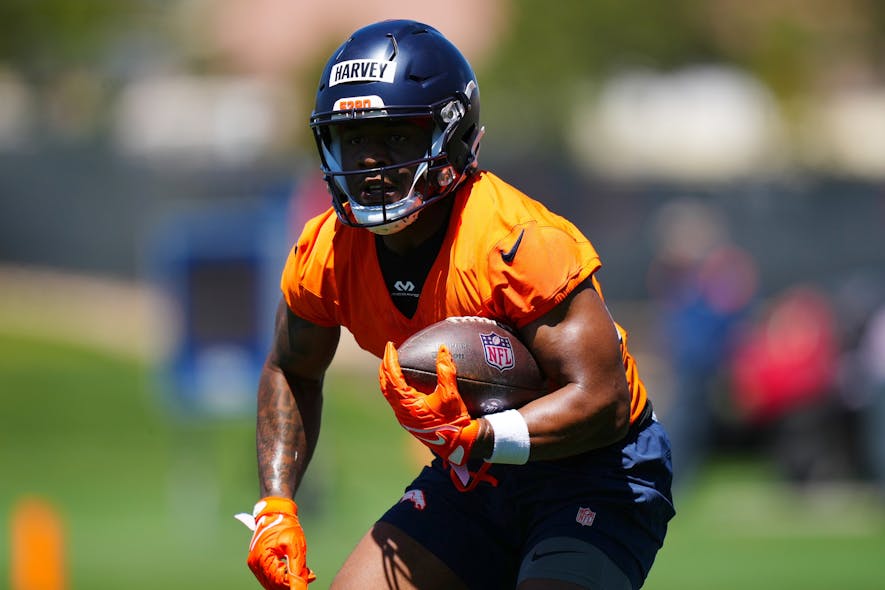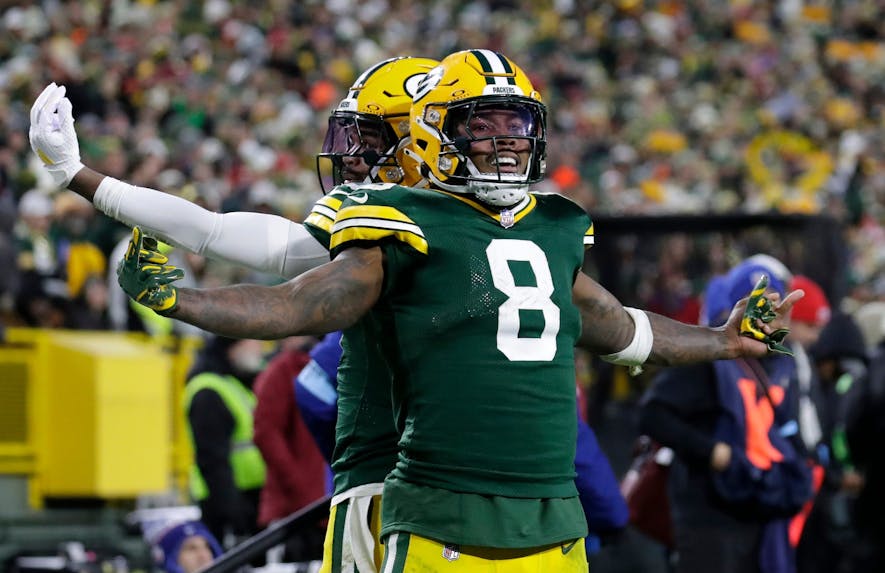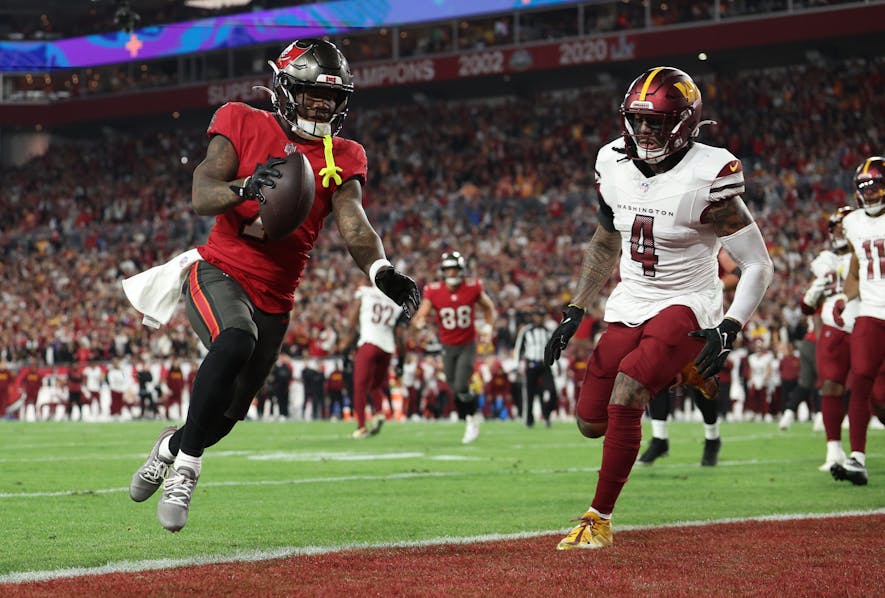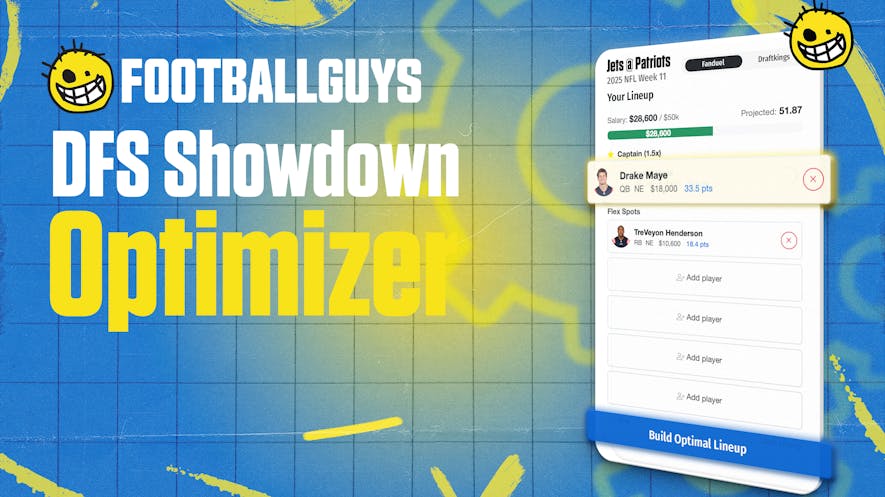Rather than a flat list of rankings, I've spent the last few years breaking players up into tiers of players with similar profiles. Age, draft capital, and production are the factors that weigh most in these buckets. A flat list of rankings isn't always helpful in dynasty, because some players should only be targeted by specific teams. For example, a team veering towards a rebuild should have no interest in the "Sniff Test" tier. But they should want to load their "Day 3 Rookies With Upside." While a list of rankings will assuredly have Aaron Jones ahead of Jarquez Hunter, it doesn't mean every dynasty manager should try to trade Hunter for Jones.
RELATED: See Dynasty Quarterback Rankings and Tiers here
RELATED: See Dynasty Wide Receiver Rankings and Tiers here
RELATED: See Dynasty Tight End Rankings and Tiers here
Inside each bucket, the players are ranked as I prefer them. So if you're a contender looking for extra firepower at running back, scroll down to the "Sniff Test" tier or the "Productive Veterans… For Now" tier, and see who you could add. Some of these buckets are labeled as players to sell. And I'll rank those according to who will net the most significant return.
Let's dive in, starting with the obvious crème de la crème.
Blue Chips
All these running backs were drafted inside the top 12 and will play the 2025 season at age 23 or younger. Bijan Robinson and Jahmyr Gibbs finished behind only Saquon Barkley in PPR scoring last year. They catch passes, score touchdowns, and make big plays, checking every box we want to see in fantasy. Ashton Jeanty is an elite prospect with eye-popping film, production, and efficiency who landed on a Pete Carroll and Chip Kelly team incessant on establishing the run. Picking between Robinson and Gibbs is a fool's errand based on what we've seen from both so far through their short NFL careers. But Jeanty's age could quickly move him atop this tier. He logged the second-most single-season rushing yards in NCAA history behind only Barry Sanders. With no competition on the roster and a capable passing attack led by Geno Smith, Jeanty will have the opportunity to take. We've never seen him on an NFL field, so moving him higher than RB3 is impossible. But that ranking gives him room to climb quickly in his rookie year.
Typically, I'd advocate for trading away the running backs atop dynasty rankings. However, the blend of age and draft capital in these three isn't typical of a normal dynasty market. The profiles are bulletproof, and injury likely wouldn't even cause a significant dip in value. The recent history of running backs drafted in the first half of Round 1 is excellent, and most dynasty managers are aware of it. If you can get a top quarterback (Jayden Daniels, Josh Allen, Lamar Jackson) or wide receiver (Ja'Marr Chase, Justin Jefferson, Malik Nabers) in return, you should take that offer. But don't let the running back label alone scare you away. These are safe and valuable assets.
The Saquon Barkley Tier
The only knock on Saquon Barkley's profile is his age. While he's just as likely to finish as this year's RB1 as the Blue Chips above, he's entering his age-28 season. Christian McCaffrey, Nick Chubb, and Austin Ekeler are recent examples of aging running backs who have quickly tumbled in dynasty value after injury beyond the top of the age curve. Barkley is currently one of the most volatile assets in dynasty. I don't need to explain the downside for you to imagine it. Those courageous enough to hold him could get years of elite production for the next five years. But the floor could fall out from under him at any time. He should be reserved for contending rosters, hopefully at a palatable acquisition cost.
Young, Good Profile, Productive
Okay, Omarion Hampton might not be "productive" yet, but that seems like nothing but a technicality at this point. He'll walk into a team with a tremendous offensive line led by Jim Harbaugh and Greg Roman, who have a history of leaning on the run. Breece Hall has fallen a bit after a down 2024 season. Investments in Braelon Allen and Isaiah Davis capped his upside. And with Justin Fields now in the picture, another mouth to feed could hinder his short-term production. Jonathan Taylor's story is similar. Despite undeniable talent, anemic offenses and a run-first quarterback have proved a hurdle to consistency that he cannot overcome. And as he enters his age-26 season, it's hard to move him up in rankings. Ken Walker III has floated around the low-end RB1 range for most of his career, showing flashes of brilliance while struggling with injuries and backfield competition. There's hope that Klint Kubiak's offense can focus on him. But his age makes him one of the most intriguing buys in this range. De'Von Achane has produced back-to-back RB1 seasons in fantasy, one as a game-breaking big-play weapon and another as a pass-catching machine. The versatility in his profile makes him a safer asset than you might imagine. And James Cook's production has been great since he broke out as a sophomore, but it's hard to tell if it's him or the offense he's in. A steep asking price in his contract negotiations could push him out of Buffalo and tank his dynasty value.
Most of the running backs in this tier have room to grow their value. Hampton, Hall, Achane, and Walker are all under 25. Situations can change quickly for a young running back, for better or worse. The Chargers could move on from Najee Harris after this year, handing the keys to Hampton as a three-down back. Hall has been in trade discussions and can land in a better environment. Achane and Walker have shown the tools to be elite, and a season of consistency could push them up the rankings. While those are the best-case scenarios, another season without high-end production could annoy dynasty managers enough to send their value into a freefall. Taylor's pedigree would lead us to expect a few more productive years, but there's no guarantee. But he's valued quite a bit below the other guys, with the risk baked into his consensus value. Cook is ranked even further than Taylor. A multi-year deal could stabilize his long-term floor. But going into his age-26 season, there's a lot of risk. It's harder to stomach buying Taylor and Cook than the rest of this tier. But these guys are all talented and relatively young, making them all decent trade targets.
2025 Day 2 RBs
In addition to Jeanty and Hampton in Round 1, the 2025 NFL Draft blessed us with four running backs on Day 2, all of which landed in decent or better landing spots. Quinshon Judkins was drafted ahead of TreVeyon Henderson, but Henderson gets the edge in landing spot and profile. Henderson is a big-play and pass-catching weapon, and that's what we want in fantasy. The short-term scoring outlook in New England also looks better than it does in Cleveland. RJ Harvey was a shock to a lot of people watching the draft. Already 24 years old, he's an older rookie. But he was recruited as a quarterback and still has relatively fresh legs. He was second behind only Ashton Jeanty in breakaway run rate last year, consistently ripping off big plays. Landing with Sean Payton, it's easy to envision him in roles we've seen occupied by Reggie Bush, Darren Sproles, and Alvin Kamara, all of whom were prolific fantasy compilers. Kaleb Johnson slid to Day 3, but he'll land right into a role that afforded Najee Harris one of the league's gaudiest workloads. There's hope that Johnson possesses a second gear that Harris didn't, raising his ceiling fantasy. Either way, he benefits from a great short-term landing spot, hoping to earn a long-term role in Pittsburgh.
It's hard to bet against any of these rookies, and Round 2-3 running backs have proven to have high ceilings. Judkins and Johnson's flags are similar; they profile mostly for early-down work. Those players must score many touchdowns or rip off many big plays to be viable in fantasy. While it is possible, it makes their outlooks a bit shakier. Harvey's warts are his age and size. But assuming he cedes early-down work to another back, he can be great in fantasy, as Payton's offense heavily features running backs in the passing game. Henderson is the profile that is best for fantasy football purposes. He showed elite upside as a pass-catcher in 2023. In 2024, he increased his efficiency as a runner and answered concerns about his durability. Landing in an upticking Patriots offense, he's the one you should target most aggressively in dynasty. Harvey's age can be contextualized, making the dip in value very alluring. Judkins and Johnson, while very talented, have the narrowest paths to elite fantasy ceilings. However, managers who value reliability and longevity may be more interested.
The Arbitrage Saquon Barkley Tier
It's fun labeling these tiers and fitting players into them. But there are always some guys who are tough to compare to their peers. Saquon Barkley's recent production, age, and contract security make him a great dynasty asset. Josh Jacobs checks all of those boxes as well, just with a fainter checkmark. Barkley was the RB1 last year. Jacobs was the RB6. Barkley turned 28 in February. Jacobs turned 27 in February. Barkley has four years left on his deal with an average of $20.6M annually. Jacobs has three years left on his contract, averaging $12M. Barkley was drafted second overall. Jacobs was drafted 24th. Barkley was on the league's second-best rushing offense. Jacobs was on the league's fifth-best.
Jacobs is significantly cheaper than Barkley in dynasty markets. But he's a year younger and has a similar, albeit slightly less impressive, profile. Jacobs is a bit too old for the "Young, Good Profile, Productive" tier. And he's a bit too young to get lumped in with the "Sniff Test" tier below. And his profile and production don't give him the same risk as the other "Productive Veterans." Jacobs is a fantastic target for contenders. He won't cost you nearly as much as the high-end running backs, but will hopefully provide similar production for the next few years.
Day 3 Firesale
It's hard to differentiate fool's gold from a flash in the pan from the real thing. But more often than not, cashing in on Day 3 running backs who spike in value is a good process. Career longevity is closely tied to draft capital. Of course, we remember the outliers. Arian Foster, Aaron Jones Sr., James Conner. But for every one of those, there are dozens of Jordan Howards and James Robinsons and Dameon Pierces. There's a lot to like about Bucky Irving. We can contextualize his slide in the draft. And his rookie-season efficiency was very impressive. And Chase Brown took over as a workhorse last year on one of the league's best offenses. The team did little to address the running back room this offseason. So it's easy to see why people would want to hold these players. But if they don't come out with their anticipated role in Week 1, their value will tailspin. Kyren Williams is an excellent example of a Day 3 hit at running back. But over the last two years, the Rams have invested hefty draft capital in Blake Corum and Jarquez Hunter. With Williams in the final year of his deal, a departure from Los Angeles could tank his value. And Tyrone Tracy Jr just needed a fourth-round rookie to quell the excitement surrounding him.
I won't stop you if you want to roll the dice and think one of these players is the next outlier. It's good to have conviction in players. I like what we saw from Bucky Irving last year and understand why some dynasty managers might not want to part with him. But having a process in dynasty is essential. It keeps you from getting emotionally attached to players. Part of my process is to sell Day 3 running backs after they spike in value. If I can get a first-round rookie pick for Irving or Brown, I may miss out on a few more years of elite production. But the more likely case is that I'd get a safer asset with better draft capital and a longer career outlook.
Sniff Test
You don't know what you're getting with this tier. You reach into the fridge. Derrick Henry has been teetering near his expiration date for years and keeps churning out RB1 seasons. Christian McCaffrey had a blistering 2023 campaign before a season-long injury crushed his value. Joe Mixon, Alvin Kamara, and David Montgomery all saw late-season dips in efficiency and usage. James Conner and Aaron Jones Sr. are both 30 years old. When acquiring these players, you could get a few years of top-ten production or a player who isn't worth flex consideration by Week 6. These players should only be acquired by contenders, and hopefully for less than market value. As the season approaches, the price will go up. So buying them now, amid rookie fever, is a savvy move.


_jpg)





